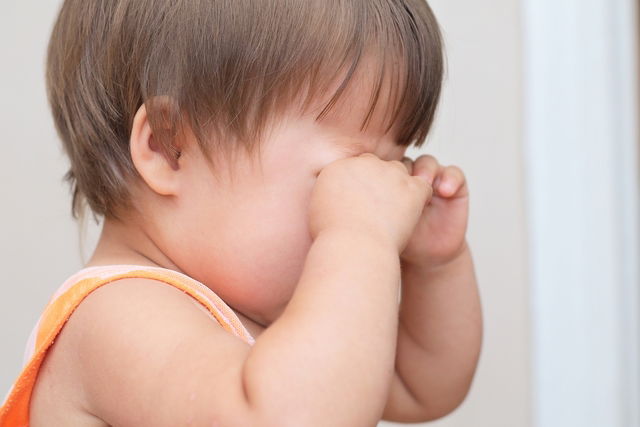Pink eye in babies is characterized by eye redness, irritability and discomfort. Babies will often rub their eyes frequently due as a result, which may worsen symptoms if left untreated.
Most often, pink eyes in babies is caused by a viral or bacterial eye infection, also referred to as bacterial or viral conjunctivitis.
If you suspect your baby may have pink eye, the baby should be assessed by a pediatrician or pediatric ophthalmologist. Treatment depends on the type of conjunctivitis and may involve the use of antibiotic eye drops, antihistamines, and keeping the eye clear of secretions.

Main symptoms
The most common symptoms of pink eye in babies or newborns include:
- Red or irritated eyes
- Tearing eye
- Crusting eyes with thick white or yellow discharge
- Itchy eyes, prompting the baby to rub his/her eyes frequently
- Mild swelling on the eyelids or around the eyes
- Hypersenstivity to light
- Irritability or difficulty eating
- Fever, particularly with bacterial conjunctivitis .
This symptom may be present in just one eye or both eyes, with both eyes usually being affected with allergic conjunctivitis. It is important for the baby to be assessed by a pediatrician or ophthalmologist to confirm a diagnosis and orient treatment, which will depend on the type of conjunctivitis.
Possible causes
Pink eye in babies can be caused by:
- Eye infections from microorganisms, such as bacteria, viruses or fungi
- Allergies, due to contact with pollen, mold or dust
- Side effect of eye drops such as silver nitrate and antibiotic eye drops, which can cause eye irritation.
Sometimes, a blocked tear duct can be confused with pink eye in babies due to similar symptoms such as watery or yellow secretions coming out of the eyes.
Also recommended: Newborn Eye Discharge: Causes & How to Clean Eyes tuasaude.com/en/newborn-eye-dischargeTreatment options
Treatment for pink eye in babies is as follows:
1. Bacterial conjunctivitis
It is common to experience more eye crust with bacterial pink eye, a symptom that can affect both eyes. This type of pink eye usually requires antibiotic treatment with eye drops, ointments or syrups.
In addition, it important to keep the eyes clean and free of discharge, as discharge can promote the growth of more bacteria and delay recovery.
Bacterial pink eye that is left untreated can lead to complications like meningitis or penumonia, It is important to follow treatment as instructed by the doctor to prevent complications and ensure the baby’s recovery.
2. Viral conjunctivitis
In these cases, treatment typically involves just cleaning the eyes with clean gauze soaked in saline, filtered water or mineral water. This type of pink eye generally resolves on its own within a week without medical interventions.
Some eye drops, particularly moisturizing eye drops, may be prescribed by a doctor, but their objective is just to reduce discomfort.
3. Allergic conjunctivitis
Allergy-related pink eye is triggered by an allergy to a product or substance. Symptoms can usually be relieved with antihistamines or cortisone, which reduce the body’s immune response.
Other important measures
When treating pink eye in babies, it is essential to follow treatment as directed, as well as adopt certain measures to ensure full recovery. These can include keeping the eye clean by using clean tissues and opting for a new one every time.
Other important considerations are:
- Keeping the baby home while symptoms are present
- Washing the baby’s face and hands several times per day
- Avoid hugging or kissing the baby while the infection is active
- Changing the baby’s pillow case and bath towel every day
These considerations will help to prevent spread of the infection to the baby’s other eye, as well as prevent transmission to other people.
You should not apply breastmilk to the baby‘s eye, as there are not studies that prove its efficacy with these types of infections. Boric acid is completely contraindicated for the treatment of pink eye.
